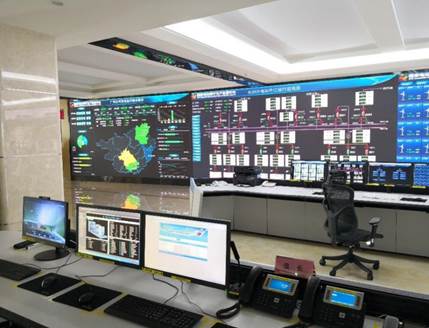Main Participants: Gong Chuanli, He Ting, He Feiyue, Han Changlin, Zhang Weijun, Chen Xiaosong, Liu Xiaotong, Mao Qi, Chi Hailong, Zhang Zimin, Feng Binchun, Zhou Wen, Gu Dongyong
At the 75th United Nations General Assembly in September 2020, President Xi Jinping announced that China aims to peak CO2 emissions before 2030 and achieve carbon neutrality before 2060. To achieve these "dual carbon" goals, China needs to transform its current energy mix, which is currently dominated by fossil fuels, and vigorously promote the development of renewable energy power plants. Centralized control of wind and photovoltaic power generation is an essential means of reducing management costs and improving equipment operational efficiency. However, wind and photovoltaic power generation is subject to weather conditions, leading to volatility and randomness. Hydro-wind-photovoltaic multi-energy complementarity can help address this issue. Complementarity between hydropower and renewable energy can convert the widely perceived unstable “junk electricity” produced by the renewable energy grid into high-quality electricity like hydropower. Therefore, conducting research on key technologies for centralized control of renewable energy and multi-energy complementarity is significant.
· Studying the design principles, structural pattern and hierarchy of centralized renewable energy control systems with hydro-wind-photovoltaic power stations connected, and building an integrated platform for hydro-wind-photovoltaic power under the overarching principles of "integration, standardization, modularization and intelligence";
· Studying the data network building plan, which including network structure and communication protocol, for centralized control systems and power stations. As well as designing the security system structure for the data network of the centralized control, and extending the communication protocol appropriately as needed;
· Studying the methods for wind and photovoltaic power forecasting to be combined with numerical weather prediction to improve the accuracy of forecasts;
· Studying the coordinated control technologies for hydro-wind-photovoltaic multi-energy complementarity, which aims to achieve "peak load shaving and load curve smoothing". This process involves converting wind power and photovoltaic power into high-quality electricity like hydropower which will ultimately improve the power grid’s ability to accommodate renewable energy sources;
· Studying methods for developing hydro-wind-photovoltaic power generation plan curves with the ultimate goal of reducing the impact of prediction errors on dispatching and control.
· Having designed a universal platform for centralized control system of renewable energy, as well as a control hierarchy and security protection system based on the communication characteristics and requirements of the systems. The development of multi-channel cluster communication technology has also solved the problem of massive data collection. An intelligent alarm software has been created, and the IEC60870-5-104 protocol has been appropriately expanded as needed. In addition, an industriral standard entitled "Extended Guideline for Network Communication Protocols for Hydropower Plants Based on IEC60870-5-104" has been drafted.
· Having established photovoltaic power prediction model based on maximum information entropy theory and wind power prediction models using wavelet-BP neural networks. These models have improved the prediction accuracy. Additionally, a method for developing the power generation plan curves of hydro-wind-photovoltaic complementarity based on prediction information has been proposed. With this method, prediction information is classified and processed to reduce the impact of prediction errors of the power grid.
· Having developed a coordinated control technology for hydro-wind-photovoltaic multi-energy complementarity based on "virtual hydropower generating units", which uses hydropower units to perform complementary scheduling of new energy generation of different scales in the long-term, medium-term, short-term and ultra-short-term. This technology converts renewable energy into high-quality electricity like hydropower, thereby improving the accommodation capacity for renewable energy.
The achievements of this project were first demonstrated in the Longyangxia hydro -photovoltaic complementary power station, filling the gap in key technologies for large-scale hydro-photovoltaic complementary power generation at home and abroad. Currently, it has been successfully applied to the control center for hydro-wind-photovoltaic power generation in Chuxiong, Yunnan, control centers of the State Power Investment Corporation Limited (SPIC) respectively in Nanchang and Nanning, Guangxi, etc., and having brought about significant economic and social benefits.With the explosive growth of renewable energy, the research findings are expected have broad prospects for promotion and application.

Fig.1 Schematic diagram of hydro-photovoltaic complementary power generation at the Longyangxia Hydropower Station
Fig.2
Longyangxia hydro-photovoltaic complementary power station

Fig.3
Technology for coordinated control of multi-energy complementarity

Fig.4 SPIC Control Center in Nanchang

Fig.5 SPIC Control Center in Nanning